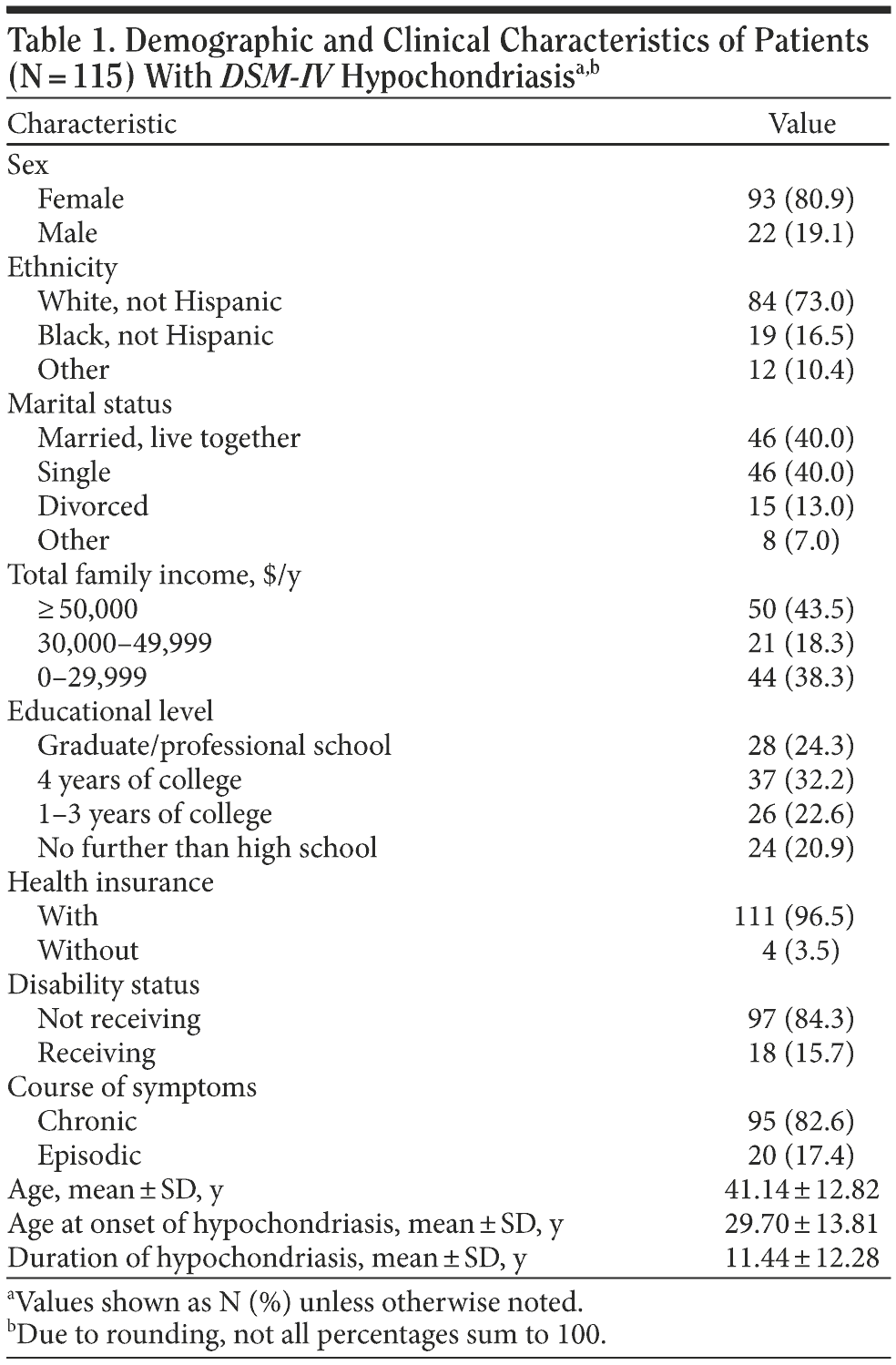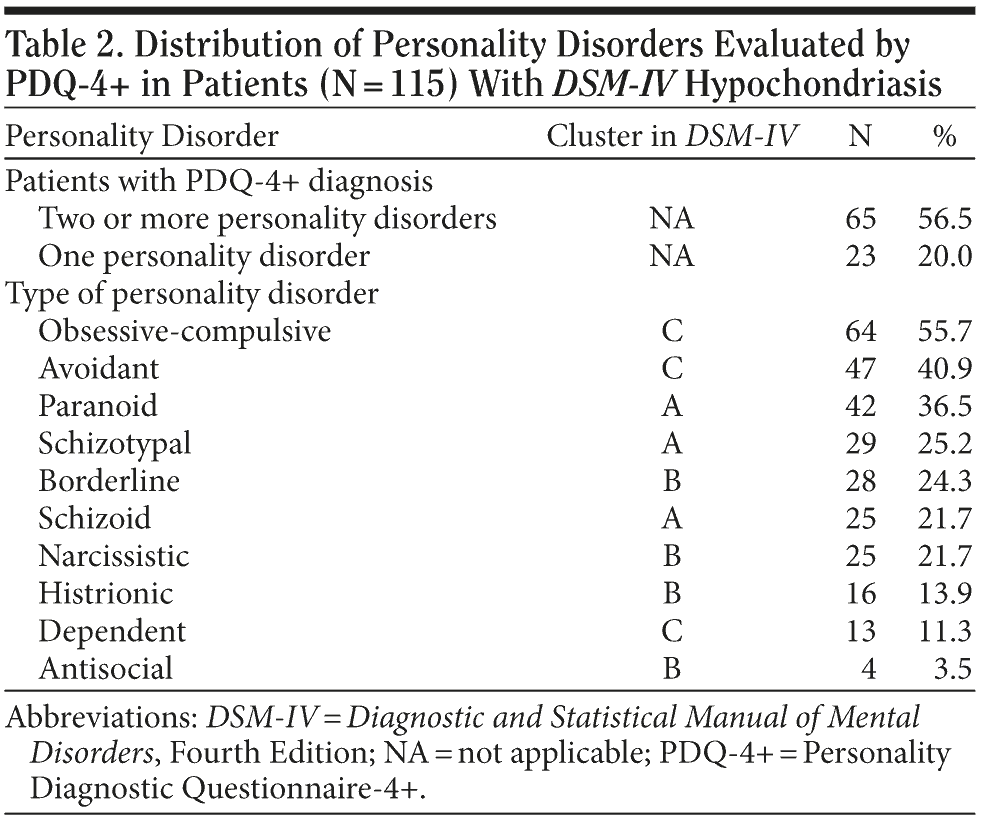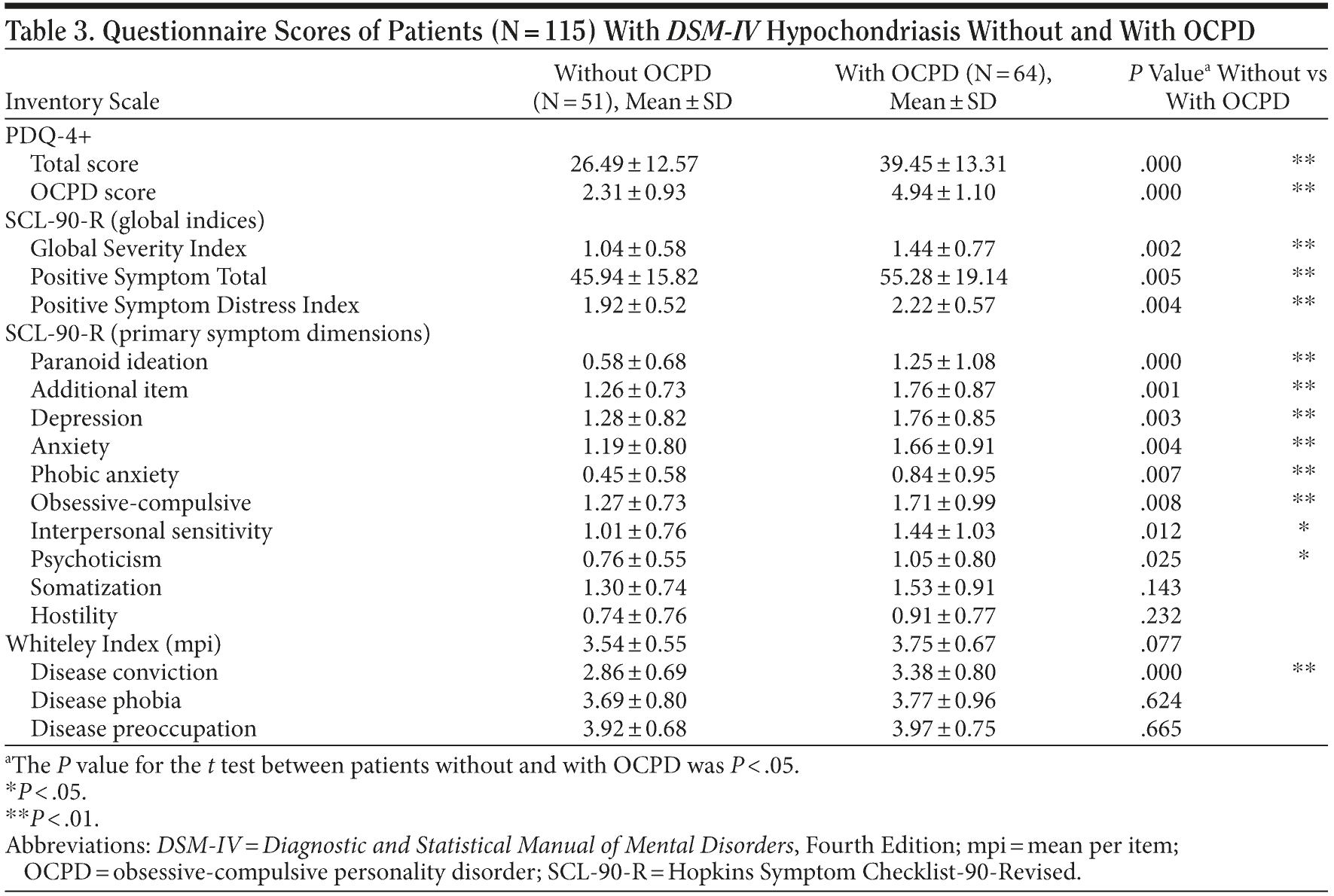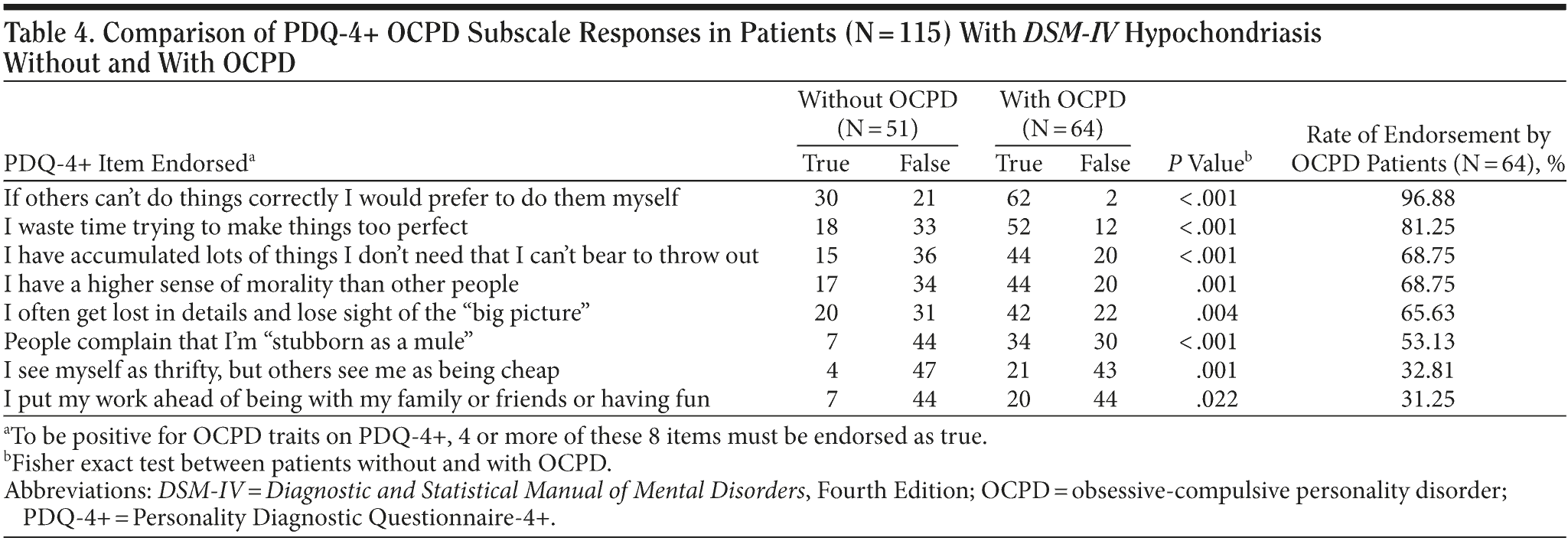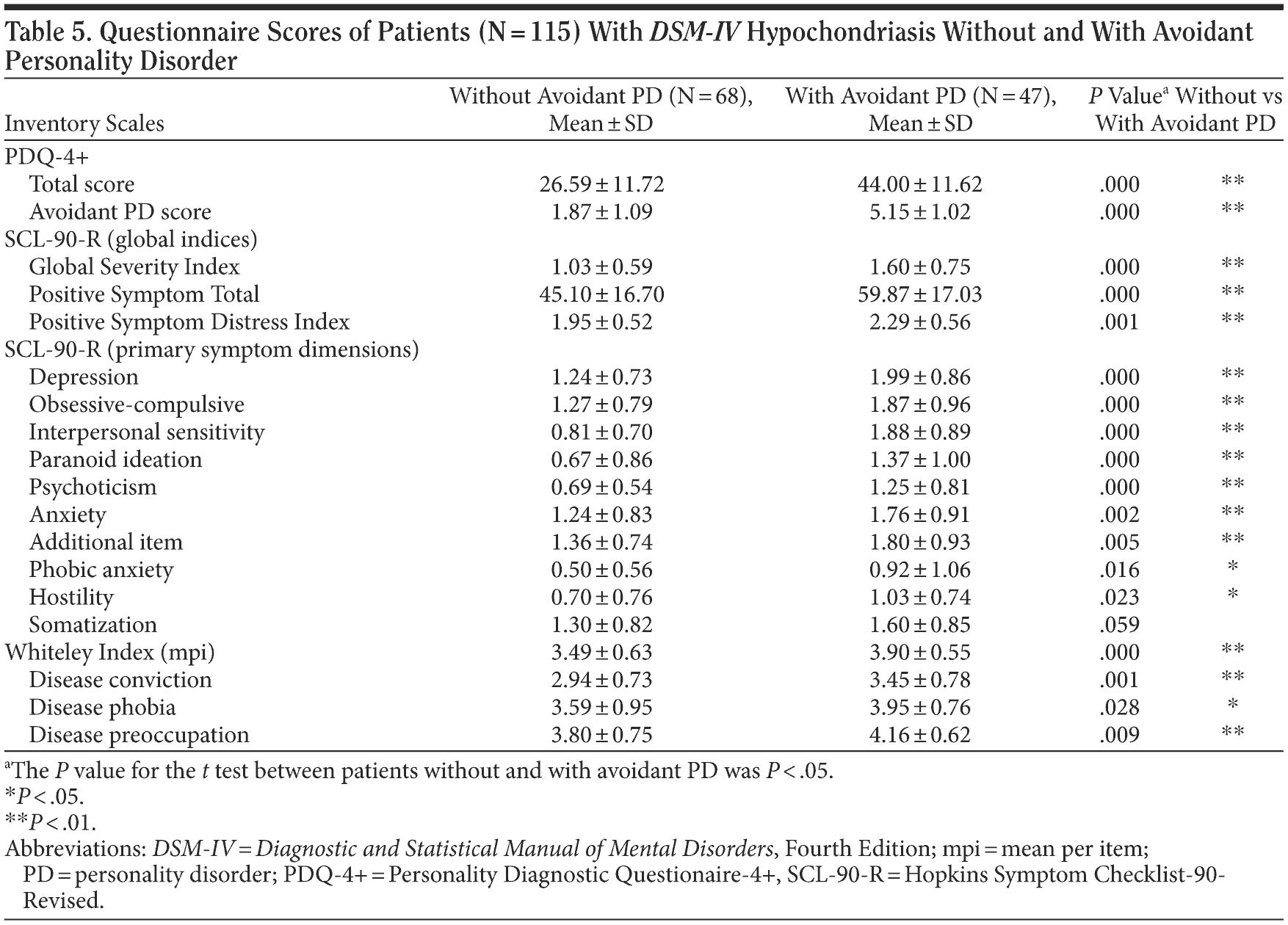Background: Although Axis I hypochondriasis is closely related to certain personality characteristics, the nature and extent of personality dysfunction in these patients still needs clarification. This study assessed the prevalence of personality disorders observed in hypochondriacal patients, described the types and comorbidity of personality disorders, and compared the psychological distress of patients with and without the most common comorbid personality disorder.
Method: One hundred fifteen patients meeting Diagnostic and Statistical Manual of Mental Disorders, Fourth Edition, criteria for hypochondriasis completed self-administered assessments, including the Personality Diagnostic Questionnaire-4+ (PDQ-4+), the Hopkins Symptom Checklist-90-Revised (SCL-90-R), the Whiteley Index, and the Somatic Symptom Inventory. These data were taken from a study conducted between September 1997 and November 2001.
Results: Eighty-eight patients (76.5%) had 1 or more personality disorders, whereas 27 patients (23.5%) had no personality disorders. Fifty-one patients (44.3%) had more than 3 personality disorders. The most common personality disorder in the hypochondriacal patients was obsessive-compulsive personality disorder (OCPD; 55.7%), followed by avoidant personality disorder (40.9%). The comorbidity of OCPD and avoidant personality disorder was 53.1% (34 of 64 patients with OCPD). The total PDQ-4+ score of the 64 patients with OCPD was significantly higher than that of the 51 patients without OCPD. On the SCL-90-R, the 64 patients with OCPD showed significantly higher scores on all of 3 global indices and 7 of 10 primary symptom dimensions (paranoid ideation, depression, anxiety, phobic anxiety, obsessive-compulsive, interpersonal sensitivity, and psychoticism) on the SCL-90-R compared to the 51 patients without OCPD.
Conclusions: The high prevalence of personality disorders, particularly OCPD, among patients with hypochondriasis suggests that consideration of personality features is important in assessment and therapeutic interventions for hypochondriasis.
Submitted: October 3, 2008; accepted February 12, 2009
Corresponding author and reprints: Reiko Sakai, MD, Department of Psychiatry, Brigham and Women’s Hospital (c/o Arthur J. Barsky, MD), 75 Francis St, Boston, MA 02115 ([email protected]).

The Prevalence of Personality Disorders in Hypochondriasis
Background: Although Axis I hypochondriasis is closely related to certain personality characteristics, the nature and extent of personality dysfunction in these patients still needs clarification. This study assessed the prevalence of personality disorders observed in hypochondriacal patients, described the types and comorbidity of personality disorders, and compared the psychological distress of patients with and without the most common comorbid personality disorder.
Method: One hundred fifteen patients meeting Diagnostic and Statistical Manual of Mental Disorders, Fourth Edition, criteria for hypochondriasis completed self-administered assessments, including the Personality Diagnostic Questionnaire-4+ (PDQ-4+), the Hopkins Symptom Checklist-90-Revised (SCL-90-R), the Whiteley Index, and the Somatic Symptom Inventory. These data were taken from a study conducted between September 1997 and November 2001.
Results: Eighty-eight patients (76.5%) had 1 or more personality disorders, whereas 27 patients (23.5%) had no personality disorders. Fifty-one patients (44.3%) had more than 3 personality disorders. The most common personality disorder in the hypochondriacal patients was obsessive-compulsive personality disorder (OCPD; 55.7%), followed by avoidant personality disorder (40.9%). The comorbidity of OCPD and avoidant personality disorder was 53.1% (34 of 64 patients with OCPD). The total PDQ-4+ score of the 64 patients with OCPD was significantly higher than that of the 51 patients without OCPD. On the SCL-90-R, the 64 patients with OCPD showed significantly higher scores on all of 3 global indices and 7 of 10 primary symptom dimensions (paranoid ideation, depression, anxiety, phobic anxiety, obsessive-compulsive, interpersonal sensitivity, and psychoticism) on the SCL-90-R compared to the 51 patients without OCPD.
Conclusions: The high prevalence of personality disorders, particularly OCPD, among patients with hypochondriasis suggests that consideration of personality features is important in assessment and therapeutic interventions for hypochondriasis.
J Clin Psychiatry 2010;71(1):41-47
© Copyright 2010 Physicians Postgraduate Press, Inc.
Submitted: October 3, 2008; accepted February 12, 2009 (doi:10.4088/JCP.08m04838blu).
Corresponding author and reprints: Reiko Sakai, MD, Department of Psychiatry, Brigham and Women’s Hospital (c/o Arthur J. Barsky, MD), 75 Francis St, Boston, MA 02115 ([email protected]).
People who suffer from hypochondriasis experience a great deal of distress with few effective treatment options. Hypochondriasis also poses unique problems of high utilization of medical care, high medical cost, and patient-provider dissatisfaction. There have also been several suggestions about the possible association between hypochondriasis and personality disorders,1-6 particularly obsessive-compulsive personality disorder.2,5 Although the symptoms of hypochondriasis and personality disorders are well described in the Diagnostic and Statistical Manual of Mental Disorders, Fourth Edition (DSM-IV),7 2 fundamental questions remain unanswered: (1) "How closely is hypochondriasis associated with Axis II personality disorders?"3 and (2) "What is the relationship between hypochondriasis and obsessive-compulsive personality disorder (OCPD)?"2,5
In order to measure the prevalence of personality disorder, functional impairment, and hypochondriacal symptoms among hypochondriacal patients, Barsky et al4 administered diagnostic interviews and self-report questionnaires to 118 patients, who were divided into 2 groups by a cutoff score for hypochondriacal symptoms. They reported that patients above the hypochondriasis cutoff had twice as many lifetime Axis I diagnoses, twice as many symptoms, and 3 times the level of personality disorder symptoms as the patients below the cutoff score. In the Barsky et al study,4 a cutoff score on the PDQ (Personality Diagnostic Questionnaire) was used to identify high and low personality disorder groups; however, the types of personality disorders and their relationship to hypochondriasis were not explored further. Garyfallos et al5 administered the Structured Clinical Interview for DSM-III-R Axis II Disorders (SCID-II) in a psychiatric outpatient sample and found that 74% (17 of 23) hypochondriacal patients had some personality disorder; of these, 22% (5 of 23) had either histrionic personality disorder or OCPD. However, the sample with hypochondriasis in the Garyfallons et al study5 was small, and there are few data regarding personality disorders among hypochondriacal patients. Therefore, the prevalence, nature, and extent of personality disorders among patients with hypochondriasis still need further investigation and clarification.
The aims of this study are (1) to assess the prevalence of personality disorders in patients with hypochondriasis, (2) to identify the particular personality disorders most commonly associated with hypochondriasis, and (3) to compare the level and type of psychological distress of hypochondriacal patients with or without the most common personality disorder.
METHOD
Sample
The data were taken from a study8 of 187 hypochondriacal patients, including 115 patients who were diagnosed with DSM-IV hypochondriasis. Signed informed consent was obtained in accordance with the Brigham and Women’s Hospital Human Research Committee requirements. Patients who met initial eligibility criteria and exceeded the screening cutoff completed the baseline research battery, which included self-report questionnaires, a structured diagnostic interview, and a determination of their medical morbidity. The precise cutoff score of 150 (range, 52-258), derived from the Whiteley Index9,10 and Somatic Symptom Inventory (SSI),11-14 was determined from previous studies.15-17 The formula for this cutoff score was designed to assess equally the 4 major dimensions of hypochondriacal symptoms: disease conviction, disease phobia, and disease preoccupation (evaluated by Whiteley Index) and somatization (evaluated by the SSI). The cutoff score was weighted such that three quarters of the score was based on the Whiteley Index and one quarter of the score on the SSI. The DSM-IV diagnosis of hypochondriasis was made using the Structured Diagnostic Interview for Hypochondriasis (SDIH), which was developed in previous work18 and has been subsequently integrated into the Structured Clinical Interview for DSM-IV Axis I Disorders (SCID-I/P).19 The SDIH has good concurrent, external, and discriminant validity and interrater reliability.18
For Clinical Use
- The prevalence and types of comorbid personality disorders in hypochondriasis are now emerging.
- More than three-quarters of the patients with hypochondriasis had personality disorders, and the most common type was OCPD (obsessive-compulsive personality disorder).
- Clinicians may consider personality features in therapeutic interventions for hypochondriasis.
The inclusion criteria were age older than 18 years, English fluency and literacy, and having seen a primary care physician in the last 12 months. Exclusion criteria included major medical morbidity expected to worsen significantly in the next 12 months; somatoform pain disorder; psychosis or suicide risk; and ongoing, symptom-contingent disability determinations, workers’ compensation proceedings, or litigation.8 Data were collected from September 1997 through November 2001.8
Assessment Tools
The Personality Diagnostic Questionnaire-4+ (PDQ-4+)20 is a self-rating questionnaire that assesses the extent and nature of personality disorders. The PDQ-4+ is a revised form of the Personality Diagnostic Questionnaire (PDQ),21,22 and it assesses the 10 types of personality disorders in DSM-IV (cluster A: paranoid, schizoid, and schizotypal; cluster B: histrionic, narcissistic, antisocial, and borderline; and cluster C: avoidant, dependent, and obsessive-compulsive) as well as negativistic and depressive personality disorders in the Appendix of DSM-IV.23,24 The PDQ-4+ consists of 99 true/false items, with a higher score indicating more severe traits of personality disorders. Each personality disorder is determined by its own cutoff score. The PDQ-4+ shows a reasonable degree of reliability and validity, 24 with a test-retest reliability of .868. Item scores of subscales and means of subscales in the PDQ-4+ showed high correlation coefficients (ie, high internal consistency).24
The Hopkins Symptom Checklist-90-Revised (SCL-90-R)25,26 is used to assess psychiatric morbidity. It is a widely used 90-item instrument that has excellent psychometric properties and provides an overall measure of generalized psychiatric distress. It provides 3 global indices and 10 primary symptom dimensions. A higher score signifies more severe psychological distress.
The Whiteley Index9,10 is used to assess hypochondriacal attitudes and beliefs. It is a widely used 14-item questionnaire whose validity, reliability, and sensitivity to change have been demonstrated. It consists of 3 subscales with higher scores indicating more severe symptoms.
The Somatic Symptom Inventory (SSI)11-14,16,17 is a questionnaire that evaluates hypochondriacal somatic symptoms. The reliability, internal consistency, and convergent validity of this 26-item questionnaire have been demonstrated.11-14,16,17 A higher score indicates more somatic distress.
Statistical Analysis
Analyses were done using SPSS version 16.0 (SPSS Inc., Chicago, Illinois) for personal computers. Comparisons between 2 groups were performed using an independent t test for normally distributed continuous variables. For categorical data, the Fisher exact test for qualitative variables was used. Significance values are P < .05 (2-tailed). In order to compare our data with the normal data sample from the SCL-90-R manual,26 we used GraphPad Software (GraphPad Software Inc., La Jolla, California) and evaluated t test based on Bonferroni’s Pnew values (= .05/N).
RESULTS
The 115 patients meeting DSM-IV criteria for hypochondriasis were predominantly female and middle-aged and reported a history of hypochondriasis for approximately 11 years (Table 1).
On the PDQ-4+, 88 patients (76.5%) met criteria for one or more personality disorders, whereas 27 patients (23.5%) had no personality disorders (Table 2). Fifty-one patients (44.3%) had more than 3 personality disorders. The most common personality disorder was OCPD r (55.7%), followed by avoidant personality disorder (40.9%). The comorbidity of OCPD and avoidant personality disorder was 53.1% (34 of 64 patients with OCPD).
Since OCPD was the most common comorbid personality disorder, we examined the features of this subgroup further. We compared these 64 patients with OCPD to the remaining 51 patients without OCPD (Table 3). The total PDQ-4+ score of those with OCPD was significantly higher than the score of those of without OCPD. After removing the score comprising the OCPD subscale from the total PDQ-4+ score, the mean ± SD PDQ-4+ score remained significantly higher in patients with OCPD than in patients without OCPD (34.52 ± 12.90, 24.18 ± 12.12, respectively, P < .001). The 8 items in the PDQ-4+ endorsing the OCPD score are shown in Table 4.
On the SCL-90-R, the patients with OCPD had significantly higher scores than patients without OCPD in 3 of the global indices and 8 of 10 primary symptom dimensions (excluding somatization and hostility subscales). On the Whiteley Index, patients with OCPD showed significantly higher scores in disease conviction than patients without OCPD, although no significant differences were shown in the other subscales.
We also compared the 47 patients with avoidant personality disorder to the 68 patients without avoidant personality disorder (Table 5). The data distribution in SCL-90-R showed a similarity to that of the analysis with OCPD; those with avoidant personality disorder showed significantly higher scores in all of the global indices and primary symptom dimensions except somatization. On the Whiteley Index, patients with avoidant personality disorder showed significantly higher scores on every subscale than did patients without avoidant personality disorder.
In order to evaluate the extent to which our patients are basically somatized in comparison to a psychiatric outpatient group, we compared the somatization scores of the 115 patients in the current study with a representative sample of 1,002 psychiatric outpatients in the SCL-90-R manual.26 The somatization score of the current study was significantly higher than that of the psychiatric outpatient sample (P < .001; t test; the mean ± SD scores of somatization subscales of our 115 patients and the 1,002 normative sample were 1.42 ± 0.84 and 0.87 ± 0.75, respectively). There were no differences found on the other subscales of the SCL-90-R.
DISCUSSION
While there are several studies of the prevalence of personality disorders among somatizing patients in general, none have thoroughly investigated the prevalence of personality disorders specifically among hypochondriacal patients. It is helpful to start with a discussion of the prevalence of personality disorder in somatizing patients, since the hypochondriacal patients in the current study showed significantly higher somatization scores than the psychiatric outpatients in the SCL-90-R scoring manual.26
In a prevalence study of personality disorders among somatizing patients in a general internal medicine clinic, Noyes et al27 administered the Structured Interview for DSM-IV Personality (SIDP) and the NEO Five-Factor Inventory to both somatizing and nonsomatizing patients. Noyes et al reported that 51% of somatizing patients met criteria for one or more DSM-IV personality disorders, whereas 29% of nonsomatizing patients did.27 In this Noyes et al study, a significant difference was observed in obsessive-compulsive personality disorder (OCPD) with somatizers meeting criteria more often than nonsomatizers. One of the reasons for the similarity between our results and those of the Noyes et al study might be the symptomatic overlaps between somatization and hypochondriacal symptoms.
In another study using the PDQ-4, Dammen et al28 examined the prevalence of personality disorder in patients with medically unexplained chest pain. They found that 39% of patients scored positive for at least 1 personality diagnosis and that the most common personality disorders were OCPD (23.3%), followed by avoidant (13.8%) and paranoid (13.2%) personality disorders. Our results showed a generally higher percentage of personality disorders in hypochondriacal patients compared to the rates Dammen et al identified. The order of the most prevalent personality disorders in both studies was similar.
Another study by Garyfallos et al5 showed that the prevalence of personality disorders in patients with somatoform disorders was 63% (110 of 175) and significantly higher than the rate of 52% (664 of 1,273) found in psychiatric outpatients; in addition, the prevalence of personality disorders in hypochondriasis was 74% (17 of 23). Although the sample with hypochondriasis in the Garyfallos et al study is small, our high prevalence of personality disorder supports the Garyfallos et al report.
The high rate of OCPD and psychological features of OCPD among hypochondriasis in our study also supports the close relationship between hypochondriasis and OCPD.2,5 Patients with OCPD showed evidence of more psychopathology by scoring higher on the PDQ-4+ and most of the subscales of SCL-90-R. Patients with OCPD scored significantly higher on the disease conviction subscale of the Whiteley Index compared to those without OCPD, but there was no significant difference between these groups on the disease phobia subscale. A previous study29 pointed out that hypochondriacal disease conviction, a false belief of having a disease, was predominantly associated with elevated levels of somatization, whereas hypochondriacal disease phobia was associated with anxiety. Since our patients have higher somatization than a normal outpatient sample in the SCL-90-R, the elevation of the subscales, both disease conviction and somatization, in patients with OCPD support the previous study.29
These higher scores seen in patients with OCPD are also congruent with the diagnostic features of OCPD, which include overconscientiousness; scrupulousness; inflexibility of morality, ethics, or values; and rigidity and stubbornness.30 Higher levels of perfectionism were also indicated by the PDQ-4+ items endorsing OCPD traits. Starcević2 pointed out the principal components of the psychopathology common to both hypochondriasis and OCPD: the perception of excessive threat to oneself with the consequent experience of vulnerability and insecurity, mistrust in oneself and others, greatly increased need for control, an inordinate search for security, poor tolerance and fear of uncertainty and ambiguity, and a cognitive style characterized by a struggle for control. He also mentioned that the essence of hypochondriasis and OCPD could be captured by the term chronic disorders of the measure of control and suggested that hypochondriasis could be regarded as a developmentally arrested form of OCPD.2 In concordance with Starcević’s formulation, we found a high prevalence and features of OCPD in hypochondriacal patients. This relationship also suggests the possibility that the traits of OCPD might predispose or are a vulnerability factor for hypochondriasis.
A high prevalence of avoidant personality disorder among hypochondriacal patients also seems reasonable, since clinically both are associated with social dysfunction and inhibition in new interpersonal situations. The high comorbidity of OCPD and avoidant personality disorder also supports the report of Garyfallos et al5 in that OCPD and cluster C disorders are predominant in hypochondriasis.
There are several limitations to this study. First, our study did not include a nonhypochondriacal group, and thus the findings may not distinguish hypochondriacal from nonhypochondriacal patients. Second, the PDQ-4+ is not a clinical interview but a self-administered assessment. Although it has been found to be valid and reliable24 there are questions about its high sensitivity and likelihood of false positive results when compared to structured interviews.21 Consequently, the high prevalence of Axis II diagnoses in the current study might be inflated. Third, the higher psychopathology in the patients with OCPD may be caused by the traits of other personality disorders; since the PDQ-4+ score that resulted from removing the OCPD subscale from the total PDQ-4+ score also remained significantly higher than that of patients without OCPD. Fourth, there are questions about the external validity of our results, since 589 patients out of the total 776 eligible participants who scored over the cutoff screening score for hypochondriasis were excluded from the previous study.8 This exclusion was also discussed as a limitation in the previous study. Reasons for exclusion described in the previous study are declined participation or unreachability of potential participants as well as failure to meet additional criteria. Furthermore, the patients who did consent to participate were predominantly female and highly educated and therefore might constitute a sample more receptive to a psychosocial treatment approach (ie, cognitive-behavioral therapy). It cannot be estimated whether the 589 patients were more severely hypochondriacal or suffered from any other psychiatric or personality disorders. One of the major problems in studies of somatoform disorders or hypochondriasis is that patients often resist psychosocial interventions, believing that their symptoms are medically rather than psychologically based. Future studies could be improved by integrating psychosocial treatments into primary care settings.
In recent decades, there has been much debate as to whether hypochondriasis should remain categorized as a somatoform disorder, be reclassified as an anxiety disorder placed within an obsessive-compulsive spectrum,31-33 or still be treated as "hypochondriacal personality disorder" from Axis II aspects.3 This study, which showed a high prevalence of personality disorders, particularly OCPD, among patients with hypochondriasis, might contribute to the reconceptualization of diagnostic criteria for hypochondriasis. Moreover, from clinical aspects, this high prevalence of personality disorder also suggests that more attention should be paid to personality aspects in the assessment of hypochondriasis and also when considering a therapeutic intervention for hypochondriasis.
Disclosure of off-label usage: The authors have determined that, to the best of their knowledge, no investigational information about pharmaceutical agents that is outside U.S. Food and Drug Administration-approved labeling has been presented in this article.
Author affiliations: Department of Psychiatry, Brigham and Women’s Hospital, Boston, Massachusetts (Drs Sakai, Nestoriuc, and Barsky and Ms Nolido). Dr Sakai is now with the Department of Psychiatry, Yokohama City University School of Medicine, Yokohama, Japan. Dr Nestoriuc is now with the Department of Clinical Psychology and Psychotherapy, Philipps-University Marburg, Marburg, Germany.
Author contributions: Dr Sakai had full access to the data in this study and takes responsibility for the integrity of the data and the accuracy of the data analysis. Dr Sakai and Dr Barsky planned the study and analyses. Dr Nestoriuc and Ms Nolido contributed to data integration and analysis. All authors participated in writing and revising the manuscript.
Financial disclosure: Drs Sakai, Nestoriuc, and Barsky and Ms Nolido have no personal affiliations or financial relationships with any commercial interest to disclose relative to the article.
Funding/support: National Institute of Mental Health, #NH40487.
Acknowledgment: The authors thank Zvi Shapiro, BA, Department of Psychiatry, Brigham and Women’s Hospital, Boston, Massachusetts, for editorial assistance.
REFERENCES
1. Katzenelbogen S. Hypochondriacal complaints with special reference to personality and environment. Am J Psychiatry. 1942;98:815-822.
2. Starcević V. Relationship between hypochondriasis and obsessive-compulsive personality disorder: close relatives separated by nosological schemes? Am J Psychother. 1990;44(3):340-347. PubMed
3. Tyrer P, Fowler-Dixon R, Ferguson B, et al. A plea for the diagnosis of hypochondriacal personality disorder. J Psychosom Res. 1990;34(6): 637-642. PubMed doi:10.1016/0022-3999(90)90107-F.
4. Barsky AJ, Wyshak G, Klerman GL. Psychiatric comorbidity in DSM-III-R hypochondriasis. Arch Gen Psychiatry. 1992;49(2):101-108. PubMed
5. Garyfallos G, Adamopoulou A, Karastergiou A, et al. Somatoform disorders: comorbidity with other DSM-III-R psychiatric diagnoses in Greece. Compr Psychiatry. 1999;40(4):299-307. PubMed doi:10.1016/S0010-440X(99)90131-1.
6. Hollifield M, Tuttle L, Paine S, et al. Hypochondriasis and somatization related to personality and attitudes toward self. Psychosomatics. 1999; 40(5):387-395. PubMed
7. American Psychiatric Association. Diagnostic and Statistical Manual of Mental Disorders, Fourth Edition. Washington, DC: American Psychiatric Association; 1994.
8. Barsky AJ, Ahern DK. Cognitive behavior therapy for hypochondriasis: a randomized controlled trial. JAMA. 2004;291(12):1464-1470. PubMed doi:10.1001/jama.291.12.1464.
9. Pilowsky I. Dimensions of hypochondriasis. Br J Psychiatry. 1967; 113(494):89-93. PubMed doi:10.1192/bjp.113.494.89.
10. Pilowsky I. A general classification of abnormal illness behaviours. Br J Med Psychol. 1978;51(2):131-137. PubMed
11. Weinstein MC, Berwick DM, Goldman PA, et al. A comparison of three psychiatric screening tests using receiver operating characteristic (ROC) analysis. Med Care. 1989;27(6):593-607. PubMed doi:10.1097/00005650-198906000-00003.
12. Barsky AJ, Wyshak G, Latham KS, et al. Hypochondriacal patients, their physicians, and their medical care. J Gen Intern Med. 1991;6(5):413-419. PubMed doi:10.1007/BF02598162.
13. Barsky AJ, Wyshak G, Klerman GL. Medical and psychiatric determinants of outpatient medical utilization. Med Care. 1986;24(6):548-560. PubMed doi:10.1097/00005650-198606000-00009.
14. Kroenke K, Spitzer RL, deGruy FV 3rd, et al. A symptom checklist to screen for somatoform disorders in primary care. Psychosomatics. 1998;39(3):263-272. PubMed
15. Barsky AJ, Fama JM, Bailey ED, et al. A prospective 4- to 5-year study of DSM-III-R hypochondriasis. Arch Gen Psychiatry. 1998;55(8):737-744. PubMed doi:10.1001/archpsyc.55.8.737.
16. Barsky AJ, Wyshak G, Klerman GL. Hypochondriasis: an evaluation of the DSM-III criteria in medical outpatients. Arch Gen Psychiatry. 1986;43(5):493-500. PubMed
17. Barsky AJ, Wyshak G, Klerman GL. Transient hypochondriasis. Arch Gen Psychiatry. 1990;47(8):746-752. PubMed
18. Barsky AJ, Cleary PD, Wyshak G, et al. A structured diagnostic interview for hypochondriasis: a proposed criterion standard. J Nerv Ment Dis. 1992;180(1):20-27. PubMed doi:10.1097/00005053-199201000-00006.
19. First MB, Spitzer RL, Gibbon M, et al: Structured Clinical Interview for DSM-IV-TR Axis I Disorders, Research Version, Patient Edition (SCID-I/P). New York: New York State Psychiatric Institute; 2002.
20. Hyler SE. Personality Diagnostic Questionnaire, DSM-IV Version (PDQ-4+). New York, NY: New York State Psychiatric Institute; 1994.
21. Hyler SE, Skodol AE, Kellman HD, et al. Validity of the Personality Diagnostic Questionnaire—revised: comparison with two structured interviews. Am J Psychiatry. 1990;147(8):1043-1048. PubMed
22. Hyler SE, Lyons M, Rieder RO, et al. The factor structure of self-report DSM-III axis II symptoms and their relationship to clinicians’ ratings. Am J Psychiatry. 1990;147(6):751-757. PubMed
23. Hyler SE. Personality Questionnaire, PDQ-4. New York, NY: New York State Psychiatric Institute; 1994.
24. Kim DI, Choi MR, Cho EC. The preliminary study of reliability and validity on the Korean version of Personality Disorder Questionnaire-4+ (PDQ-4+). J Korean Neuropsychiaty Assoc. 2000;39(3):525-538.
25. Derogatis LR. The SCL-90-R: Administration, Scoring, and Procedures Manual II. Towson, MD: Clinical Psychometric Research; 1983.
26. Derogatis LR. SCL-90-R: Administration, Scoring, and Procedures Manual. 3rd ed. Minneapolis, MN: National Computer Systems Inc; 1994.
27. Noyes R Jr, Langbehn DR, Happel RL, et al. Personality dysfunction among somatizing patients. Psychosomatics. 2001;42(4):320-329. PubMed doi:10.1176/appi.psy.42.4.320.
28. Dammen T, Ekeberg O, Arnesen H, et al. Personality profiles in patients referred for chest pain. Investigation with emphasis on panic disorder patients. Psychosomatics. 2000;41(3):269-276. PubMed doi:10.1176/appi.psy.41.3.269.
29. Kellner R, Hernandez J, Pathak D. Hypochondriacal fears and beliefs, anxiety, and somatisation. Br J Psychiatry. 1992;160(4):525-532. PubMed doi:10.1192/bjp.160.4.525.
30. American Psychiatric Association. Obsessive-Compulsive Personality Disorder. In: Diagnostic and Statistical Manual of Mental Disorders, Fourth Edition, Text Revision. Washington, DC: American Psychiatric Association; 2000:725-729.
31. Fallon B. Hypochondriasis vs anxiety disorders: why should we care? Gen Hosp Psychiatry. 1999;21(1):5-7. PubMed doi:10.1016/S0163-8343(98)00074-7.
32. Noyes R Jr, Stuart SP, Watson DB. A reconceptualization of the somatoform disorders. Psychosomatics. 2008;49(1):14-22. PubMed doi:10.1176/appi.psy.49.1.14.
33. Castle DJ, Phillips KA. Obsessive-compulsive spectrum of disorders: a defensible construct? Aust N Z J Psychiatry. 2006;40(2):114-120 PubMed doi:10.1111/j.1440-1614.2006.01757.x.
Enjoy free PDF downloads as part of your membership!
Save
Cite
Advertisement
GAM ID: sidebar-top
